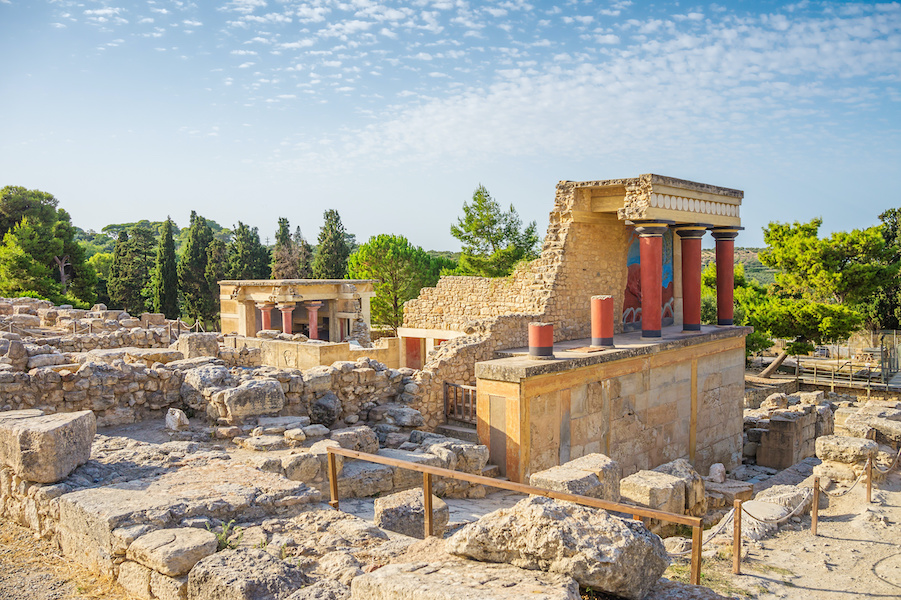
Few things can fascinate history buffs more than ancient Greek cultures...
Western civilizations have been fascinated by the ancient Greeks for literally millennia!
Two of the most ancient and most mysterious civilizations of ancient Greece were the Minoan and Mycenaean cultures.
The Minoan culture was named after Minos, a legendary figure said to be the son of Zeus and Europa who fed children to the famed Minotaur that lived in Daedalus' labyrinth. Minos is mentioned as a "King of Crete" in multiple ancient works, leading not-so-ancient archaeologists to name this ancient Cretan civilization after him.
Minoans were known for having a complex palace-based society with advanced architecture and art. Their ancient Palace of Knossos, pictured above, still displays some of their almost-4,000 year old art. According to mythology, Daedalus built this palace too.
The Mycenaean culture, on the other hand, was centered on mainland Greece and named after the ancient city of Mycenae. Though heavily influenced by the Minoans, the Mycenaeans were more known for their powerful military and impressive fortifications. Mycenae was home to legendary figures such as Agamemnon, the famed King who commanded the Greeks during the Trojan War.
Both the Minoan and Mycenaean cultures are thought to have declined and been replaced by other ancient Greek cultures more than 3,000 years ago. With so much happening in Greece after their fall (like Persian invasions and the Peloponnesian War), it's hard for historians and archaeologists to study Minoan and Mycenaean cultures beyond reading mythology and admiring the physical remnants of art and architecture. The ancient Minoan language has not even been fully deciphered.
However, analysis of ancient Minoan and Mycenaean DNA has helped shed some light.
A study by researchers from the Max Planck Institute for Evolutionary Anthropology analyzed the DNA of 102 ancient individuals from Crete, mainland Greece, and other parts of the Aegean Sea.
Published in the scientific journal Nature, this study revealed some surprising (and downright scandalous?) insights about ancient Minoan and Mycenaean cultures.
In a remarkable scientific feat, scientists were able to use genetic data to reconstruct the entire family tree of an ancient Mycenaean hamlet from roughly 3,600 years ago. This is the first time such a feat has been accomplished in studies of the ancient Mediterranean region.
As cool as this is is, there's an element to the discovery thats, um... a little awkward.
Upon assembling this ancient family tree along with the other research involved with this study, scientists realized that it was common practice for ancient Greeks from these periods to marry their first cousins.
This revelation would no doubt strike most readers today as highly unusual (to say the least), but we aren't the only ones to see it that way... This practice was highly unusual in the ancient world as well. The researchers noted that the discovery struck them by surprise, as such practices were not commonly seen anywhere else in the ancient world.
It's speculated that this bizarre practice was a method of ensuring farmland would stay within the family. Farmland, particularly for commodities like olives and wine, was a valuable asset to possess back then. By marrying cousins, ancient Greek families were able to almost-guarantee an inheritance of wealth and power. History has seen many royal families engage in similar practices for similar reasons.
While not exactly a discovery about ancient Greek culture that anyone was hoping to find, these insights into Minoan and Mycenaean family structures give scientists and historians hope that DNA can continue to provide new information about the distant past. The Minoan civilization is almost entirely lost to history, but genetic analysis allows us to piece together a more complete picture of their society and way of life.
Stay tuned as these studies of ancient genomes continue to reveal fascinating (and hopefully less weird) information about how the ancient world worked. Maybe one of YOUR ancestries will be next.